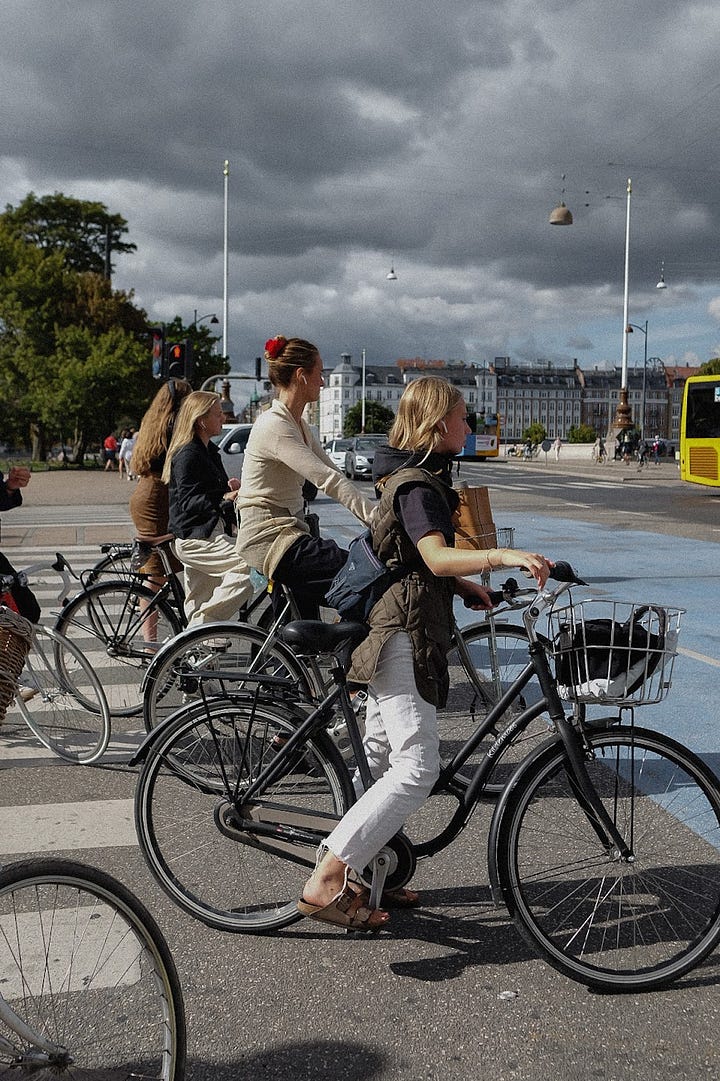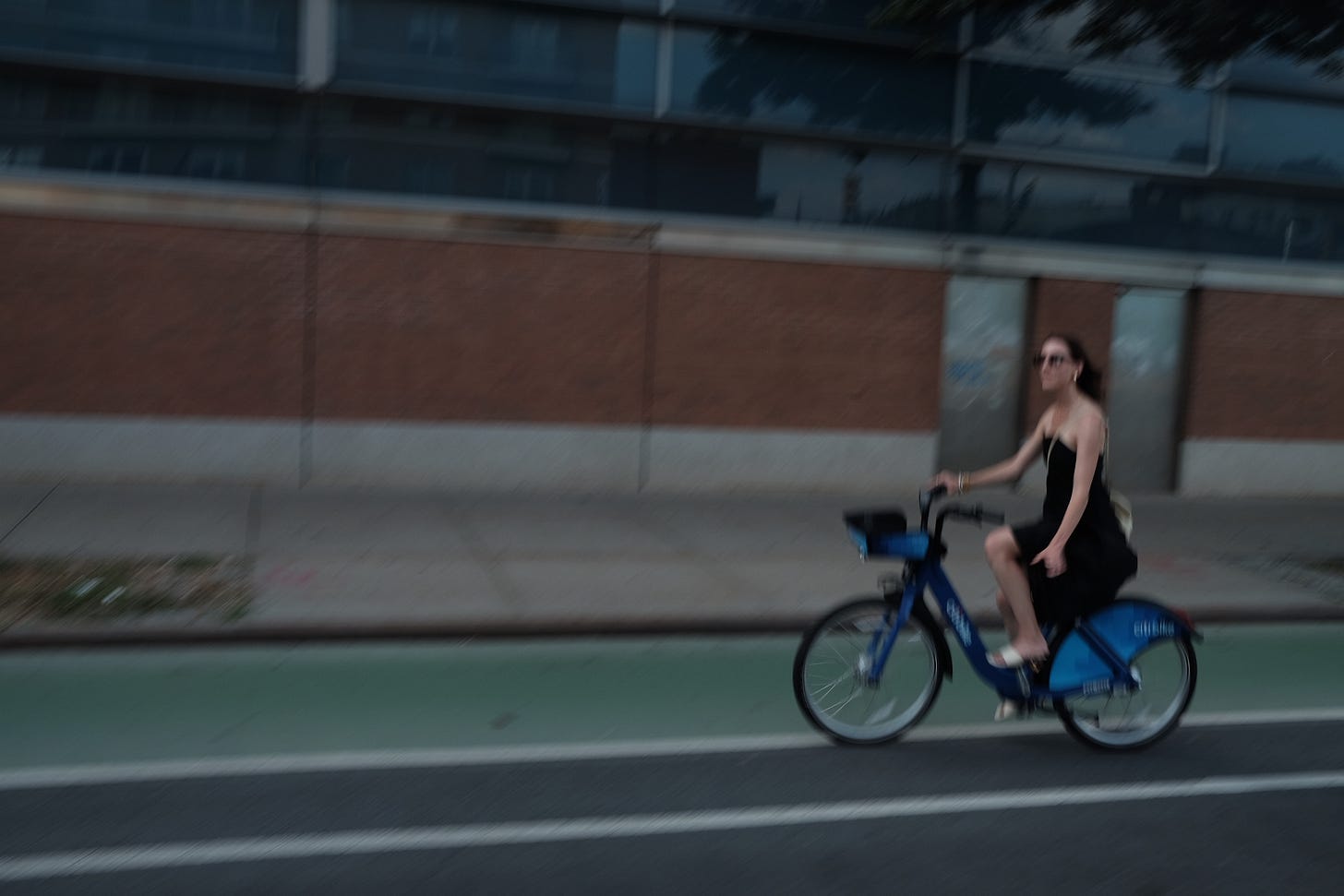Here’s something that happens to me with some regularity: I’ll be out running errands on my bike, and I’ll hear these words, tossed in my direction:
How do you bike in those?
They could be referring to the kitten heels I’ve put on with my jeans, or maybe they’re talking about the wide trousers I’ve cuffed or strapped to my legs to protect from the yank of my chain. In the warmer months, they might be talking about sandals, or one of the voluminous midi skirts I like to wear when I want nothing touching my skin.
Point being: they’re seeing my clothes, and they’re seeing my bike, and the math is not adding up.
If you’re reading this from somewhere like Copenhagen, where biking in one’s regular clothes is as much of an event as the alarm going off in the morning, this probably won’t mean much. But for my friends in US cities, stick with me.


To me, a city where it is not only possible, but common and welcome, to get on a bike in the clothes you’ve chosen for the day because you feel like wearing them is a city that is getting many things right. It’s a city where people have choices in how they get around, and each option—foot, bike, transit, car—is given the amount of space it needs to function comfortably and well. It’s a city where the air is clearer. It’s a city, probably, where people feel safe crossing the street. It’s a city where everything you need is close enough that you don’t have to plot your whole day around the task of driving to a giant grocery store: you can just pop around the corner for whatever you need. And to me, the most important thing is this: it’s a city that is filled with people who are visible to one another.
There are many reasons I choose to cycle to get around, but the main one is that when I am on my bike, I feel most connected to my surroundings. When I first moved to New York, it took me some months to gather the confidence to start riding around the city, but once I did, the whole map of it clicked into place in my mind. I knew how the neighborhoods in Brooklyn fit together; I knew the exact amount of time it took to ride from Midtown to my home across the Manhattan bridge. On my commute, I could witness the neighborhood unfold: I often was the first of my friends to notice a new coffee shop opening, or see a new mural taking shape on a wall. I loved the head-nod of passing people going the opposite way on the bridge; sometimes, I had conversations with fellow cyclists that lasted the length of the 2nd Avenue bike lane. And it’s difficult to overstate the power of looking at the distance between two places on a map, and knowing that you got yourself across it with your own strength.
The same is true now that I live in Oakland, the city where I grew up. As a child and as a teenager, I went everywhere in a car. I knew the freeway exits and what we would pass on either end of them—and that was it. I could not tell you how to walk from Rockridge to downtown, or even to Temescal. Even though it was home, I had no sense of the place. Now, after living here again for three years and biking around nearly every day, it’s coming together for me in a way that’s so much deeper. So much more of it feels within reach.
Too many cities do not make cycling feel like a safe, accessible option for people. My work revolves around changing that, and I’m lucky to be able to devote my professional time to something that matters so much to me. And when I get on a bike wearing something that makes me feel like myself, it’s my way imagining us toward the kinds of cities where all people—wearing all kinds of clothes—feel safe and welcome and relaxed on a bike.
And sure. Clothes are not infrastructure. Me riding a bike in my silver kitten heels is not at all equivalent to digging up the street and creating a protected bike lane. But clothes have power. And when it comes to cycling, they often signal something about who riding a bike is for—and who it is not for. Consider this quote from a Bay Area publication, about what springs to mind when people think “cyclist:”
They wear expensive-looking Lycra jerseys that feel like flashy overkill on city streets. The stereotype skews toward six-figure-earning, middle-aged neckbeards mansplaining about derailleurs.
The bike and the accompanying Lycra become an identity in themselves, subsuming everything else.
When I bike, I want to—and do—feel like myself. Which means wearing my own clothes. Tibi’s Amy Smilovic talks a lot about the pains of a bifurcated closet—how sequestering certain items for certain events, carving out invisible gulfs between them, limits what we can do when we dress. If one were only allowed to get on a bike in high-viz and Lycra, I’d be so much less inclined to do it. As it is, I hope that when people see me roll past in my sandals and wide pants and trench coats, they see that they don’t have to shed the part of themselves that shows up through their wardrobe if they want to try getting on a bike. And I hope that they do–because it’s pretty incredible.






Completely!! I should say--i also love adventure cycling/bikepacking and i DO have clothes/gear dedicated to that (riding 80+ miles over the mountains in jeans is not it haha). But most of my riding is around the city for errands or for fun, and for that I wear whatever I feel good in that day! Love that we share this!
I love this and your inspiring writing on urbanism x style so much!
I fell in love with urban cycling when I lived abroad in Sweden. Since coming home to Canada, I’ve definitely gotten some raised eyebrows concerning my commuting attire (as someone who used to exclusively wear skirts and dresses in the summer). Apparently, it’s cool if a finance bro bikes to work in a sweaty three-piece suit, but I look impractical zooming around in a breezy silk skirt. I also made a Reddit post about this topic years ago and got a bunch of flack for it. Your brilliant piece makes me feel seen and understood!